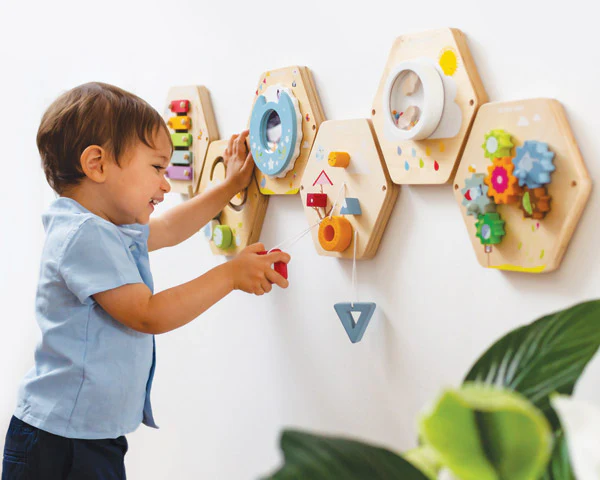Introduction
Three-year-olds are at an exciting developmental stage where play is crucial for learning. The best learning toys for this age group combine fun with educational benefits, supporting their growth in various domains. This guide highlights top choices that will engage toddlers while fostering important skills.
1. Innovative Building Blocks
Developmental Benefits: Building blocks are versatile toys that promote creativity, spatial awareness, and problem-solving skills.
Why They’re Great: With blocks of different shapes, sizes, and colors, toddlers can create endless structures. This play enhances fine motor skills, cognitive abilities, and imaginative thinking.
Examples: Classic wooden blocks, interlocking plastic blocks, and themed building sets that encourage specific designs.
2. Interactive Shape and Color Sorters
Developmental Benefits: Shape and color sorters are excellent for teaching basic concepts of shapes, colors, and sizes.
Why They’re Great: These toys challenge toddlers to match shapes to the correct slots, improving hand-eye coordination and spatial reasoning. They also help develop categorization skills.
Examples: Shape sorter toys with various shapes and colors, color-matching pegboards, and stacking rings.
3. Engaging Interactive Storybooks
Developmental Benefits: Interactive storybooks support early literacy and language development through multisensory engagement.
Why They’re Great: Touch-and-feel textures, lift-the-flap elements, and sound effects make reading interactive and enjoyable. These books help expand vocabulary and comprehension while fostering a love for reading.
Examples: Sensory books, sound books, and lift-the-flap storybooks with engaging illustrations and interactive features.
4. Musical Instruments for Toddlers
Developmental Benefits: Musical instruments help develop rhythm, auditory skills, and fine motor coordination.
Why They’re Great: Instruments like drums, xylophones, and maracas introduce toddlers to sounds and rhythms, encouraging creativity and sensory exploration. They also support motor skills and understanding of cause and effect.
Examples: Toddler-friendly drums, xylophones with colorful keys, and easy-to-hold maracas.
5. Educational Puzzles
Developmental Benefits: Puzzles enhance problem-solving skills, patience, and cognitive development.
Why They’re Great: Puzzles come in various forms, such as jigsaw puzzles and matching games, which help toddlers practice attention to detail and spatial reasoning. Educational themes, like letters and numbers, reinforce early learning concepts.
Examples: Alphabet puzzles, number puzzles, and animal-themed jigsaw puzzles.
6. Pretend Play Sets
Developmental Benefits: Pretend play sets encourage imaginative play, creativity, and social skills.
Why They’re Great: Toys like kitchen sets, doctor kits, and toolkits allow toddlers to role-play different scenarios, helping them understand everyday activities and express themselves. Pretend play also supports language development and social interaction.
Examples: Play kitchen sets, doctor kits with accessories, and toy toolkits.
7. STEM Toys for Young Learners
Developmental Benefits: STEM (Science, Technology, Engineering, and Mathematics) toys introduce basic scientific and technological concepts.
Why They’re Great: STEM toys offer hands-on experiences that foster curiosity and problem-solving. They make complex ideas accessible and engaging through interactive play.
Examples: Simple building sets, beginner coding toys, and science kits designed for young children.
8. Interactive Activity Tables
Developmental Benefits: Activity tables support fine motor skills and cognitive development with various interactive features.
Why They’re Great: With elements like spinning gears, sliding beads, and musical buttons, activity tables keep toddlers engaged while developing essential skills. Many tables include educational content that adds extra learning value.
Examples: Multi-functional activity tables with interactive elements and educational features.
9. Memory and Matching Games
Developmental Benefits: Memory and matching games improve cognitive skills, concentration, and attention to detail.
Why They’re Great: These games involve matching pairs of cards or images, which enhances memory and problem-solving abilities. They can be played alone or with others, promoting social interaction and cooperative play.
Examples: Card matching games with various themes, memory games featuring animals or letters.
10. Interactive Learning Tablets
Developmental Benefits: Learning tablets offer educational apps and games that teach fundamental skills in a digital format.
Why They’re Great: Tablets designed for toddlers feature touchscreens and engaging content that captivate young learners. They cover basic skills such as numbers, letters, and shapes, providing a modern and interactive learning experience.
Examples: Tablets with educational apps and games tailored for young children, equipped with parental controls.
Conclusion
Selecting the right learning toys for 3 year olds can greatly enhance their development while making playtime enjoyable. Building blocks, shape sorters, and interactive storybooks support cognitive and motor skills. Musical instruments, educational puzzles, and pretend play sets foster creativity and social interaction. STEM toys, activity tables, and memory games offer engaging learning opportunities, while interactive learning tablets provide a modern twist on education. By incorporating these top educational toys, you can create a rich and stimulating environment that supports your child’s growth and curiosity.



